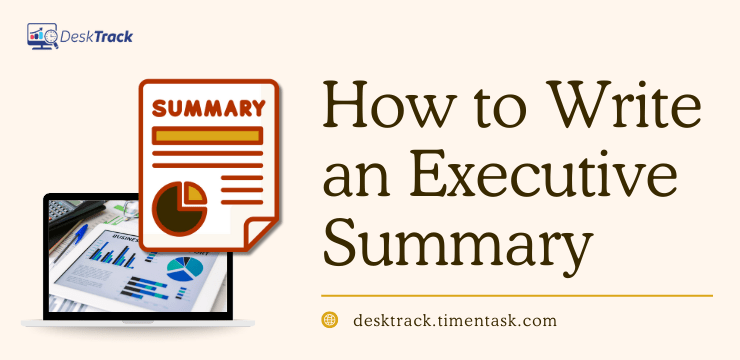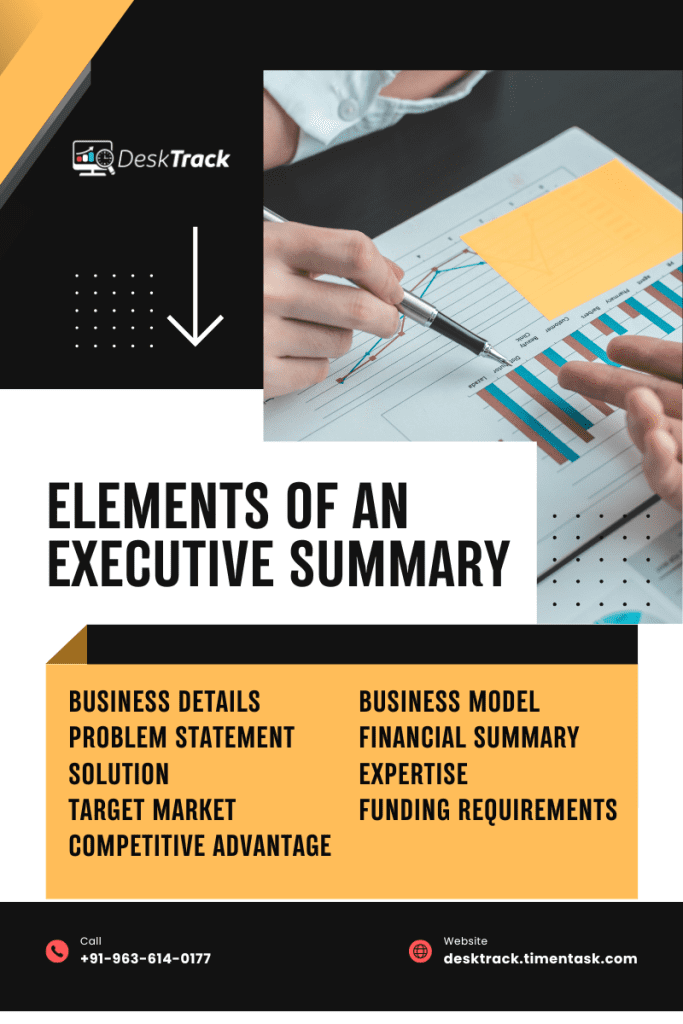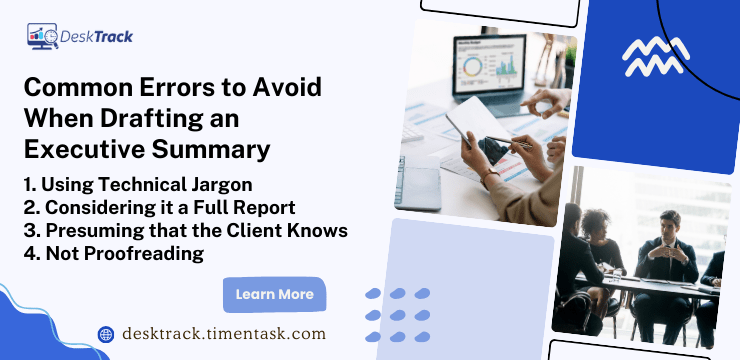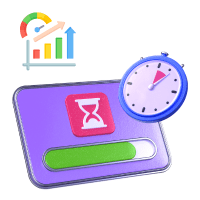
The most convincing element of project management is that it offers a way to plan, manage, and bring all of your team’s work to execution. Having this information available at a glance is frequently useful. However, for stakeholders and clients, a summary of this information is a much better option. This section of the report that summarizes your detailed proposals is known as the executive summary.
Wondering what it is, how it’s helpful, and how you can write one for yourself? In today’s blog post, we will tell you all about how to write an executive summary and even how to make the process of doing it simpler and consume less time.
What is an Executive Summary?
An executive summary outline overviews a written file, with its length and scope depending on what it summarizes. However, generally, it can fall anywhere between 1 and 2 pages. To be precise, you are required to include all the information in this report that your important stakeholders must know. Typically, executive summaries are for:
- Business cases
- Project proposals
- Research documents
- Environmental studies
- Project plans
- Market surveys
Read Also: How Many Work Hours in a Year: A Complete Guide
What is an Executive Summary in Project Management?
An executive summary in project management is a way to bring clarity to cross-functional collaborators, team leadership, and project stakeholders. Think of it like having script notes for your project for very busy human resources. How a project summary differs from its generalized version is that the traditional summary is attached after the organizational plan is wrapped up, while the project summary is written at the start of the project.
Who Uses an Executive Summary?
Anyone who has developed a fully detailed report, like an enterprise plan, can use an executive summary to provide an introduction to the content. These summarized pages have many use cases for individuals at all levels. However, its main objective is to provide a short and sweet view of any written file. Overall, the aim is to engage:
- Department heads
- Executives
- Managers
Elements of an Executive Summary

Understanding a project executive summary as a whole can be overwhelming. Especially for those who are starting a business or a project venture for the first time. Thus, we have broken it down into its various elements for you.
- Business Details: A compressed overview of the business idea, its environment, and its sector or market.
- Problem Statement: The challenge or requirement you wish to handle via your business.
- Solution: Your business’s unique product or service that solves that specific need or issue.
- Target Market: Your target audience, its size, characteristics, and demographics.
- Competitive Advantage: The USPs of your product or service, distinguishing it from others.
- Business Model: A high-level overview of your business’s revenue generation and pricing strategies, distribution channels, or any notable collaborations or partnerships.
- Financial Summary: A snapshot of your projections, including a forecast of the revenue and profits, and estimated costs.
- Expertise: Key team members with their relevant experience, skills, and expertise that contribute to your business’s success.
- Funding Requirements: The required amounts with a concise explanation of how you plan to invest the funds and expected RoI.
Purpose of an Executive Summary
So, what purpose does a project summary serve? Or you can also say, “What are the benefits of writing this report?”
- Saves Time: People can easily understand the file without reading the whole text.
- Communicates Details: Directors can pull out the main points, findings, and suggestions.
- Engages & Persuades: It inspires the directors to take action, whether approving a project or providing support to an initiative.
- Clarifies the Wider Scope: Members of the board get context for the whole file, explaining how relevant and major it is to the discussion.
Where Does an Executive Summary Go in the Report?
Generally, an executive summary begins at the initiation of the report after the topic’s name and before the table of contents. This is so that people of importance can get an idea about the solution before reading the details. Keeping this in mind, a typical project report order will be:
- Title
- Executive summary
- Table of contents
- Main body of the report
- Recommendations and conclusions
- Appendices (if required)
Parts of an Executive Summary

Even when proposing an executive summary sample, it should be clear and concise. These are the parts that you must include in the one you are writing for your project or business plan.
- Background or Introduction: The starting point for your report or proposal, which shortly explains the document. Offer a problem summary or opportunity that the report handles and its importance.
- Goals or Objectives: A clarity on what the document wishes to accomplish. Ensure to include the particular profits or outcomes the report will provide. The draft can include a solution to the problem, findings, or recommendations.
- Main Points or Key Findings: An outline of the critical insights or discoveries from the entire file. Having a compressed overview of the most crucial facts, data, or conclusions ensures that the client can easily understand the primary takeaways.
- Proposed Actions or Recommendations: The findings-based recommended steps or actions the board should take.
- Influence or Conclusion: A statement with the significance or expected influence of the proposed actions. It’s a compressed explanation of how the suggestions intend to solve the issue or be of value to the client. Outline the long-term impression.
Executive Summary vs. Project Plan
Make your workday more productive
Time tracking and work management can help you reach your goals
faster.
When learning how to write an executive summary, you must also know how it differs from your project plan.
|
A boring, detailed explanation of the key parts of your project. It states what your project will achieve to reach your goals and objectives. They include your goals, KPIs, stakeholders, roles, budget, milestones, deliverables, timelines, schedules, and communication plans. |
|
Encapsulates the most crucial information in your project plan. It includes all the crucial things your management teams require knowing when they come across your project. |
Executive Summary vs. Project Overview
When learning how to write an executive summary, you should also know how it differs from a project overview. Although both have similar elements—for instance, both include a summary of the project’s crucial information—there are a few distinctions.
|
Directly attached to your project. There is a direct link between your project and its overview. |
|
It can be included in the project. However, it can also be a stand-alone document. |
Executive Summary vs. Project Objectives
An interesting part is that your project’s executive summary contains and expands upon its objectives. Mostly in the second part. Additionally, it includes why achieving these goals will be valuable and offers details about the processes.
Steps to Draft Your Project’s Executive Summary to Perfection
After knowing all this information, we still can’t summarize all our project details. Thus, this blog will not teach you how to write an executive summary. However, we are certain that these steps will help you draft your project summary to perfection.
- Understand the Document: It is important to fully understand the content, purpose, and format of the complete report or proposal before writing. We strongly suggest grasping the main findings, recommendations, and conclusions.
- Start with the Purpose: Start with a compressed explanation of the document’s purpose. Highlight the problems, their significance, and the beneficiaries. Our expert tip is to keep this section transparent and understandable. Leave enough space for your readers to comprehend the scope.
- Highlight the Main Points: Your document must be backed by essential information indicating its purpose. You must focus on key findings, data, or arguments that led to the conclusions or recommendations. We would avoid the inclusion of too many details.
- Outline the Goals: Make it clear what the document wants to achieve, including the expected results that the recommendations will assist in accomplishing. Aligning with the findings and highlighting the overall impact of the file is important.
- Present Recommendations: Next, you need to provide actionable suggestions based on the findings. It’s the core of your executive summary, as it particulates the steps the reader requires taking. Be clear and particular while avoiding indefinite phrases. Overall, you must concentrate on solid actions that directly address the current issue.
- Conclude with the Impact: Finish your summary with some short final words that bring together the proposed recommendations and their expected impact. It is a good idea to include the wider significance of the actions, including how they will benefit the organization or stakeholders in the future.
- Keep it Concise: Be sure to keep the document limited to not more than 1 or 2 pages. It’s wise not to include any boring technical jargon or unnecessary details.
- Revise: After you are done with the first version of it, revise and remove anything that you think is unnecessary. Your executive summary must have a high level of logical flow, and it must not put your reader to sleep. Overall, the main goal is to ensure that the importance and potential influence of the actions to take are emphasized enough to keep the client.
Example of an Executive Summary
For an even better understanding, here’s the best executive summary example that covers everything we have discussed so far.
|
This document entirely evaluates our enterprise’s last year’s financial performance and proposes suggestions for improving financial stability in the next year. This document intends to inform the directorial board of the business’s finances, outline key challenges, and offer strategic actions for sustainability and expansion. |
|
This is to review the business’s financial health as we close the financial year and get ready for the next one. The report evaluates revenue patterns, costs, and cash flow, as well as our investment strategies and potential risks. The findings presented here are crucial for driving the directors’ decisions regarding fundraising, budgeting, and future investments. |
|
Revenue Growth: Income has boosted by 5% over the previous year. This is mainly because of our product line. However, the downfall is the decrease in investment revenue, accounting for our last year’s 15% revenue.
Expenditures: This year, we have experienced an 8% increase in operating expenses. This is largely due to salary hikes and operational costs linked to expansion. These expenditures align with our strategy but have impacted our bottom line. Cash Flow: Cash flow this year has remained positive. However, the enterprise’s liquidity is reducing, specifically in the last quarter. This can be a challenge if the revenue from fundraising does not meet expectations in the next one. |
|
Expand Revenue Streams: Discover new funding sources, such as corporate sponsorships, membership programs, and expanded investments to compensate for the reduction in investment revenue.
Cost Control Measures: Implement a cost control strategy to handle increasing operational expenses, such as reviewing vendor contracts and streamlining staff assignment. Develop a Cash Reserve Fund: Create a reserve fund to improve liquidity and offer a safety net for unexpected financial challenges. We propose opting for a 3-6 month operating buffer and expense. |
|
Our business has experienced significant upshifts in revenue growth and is expanding its programmatic offerings. However, there are still challenges in achieving long-term financial stability. By implementing the strategies suggested, the board can help overcome financial risks. Overall, we must concentrate on diversifying our revenue streams, managing expenses, and developing reserves, as it will help safeguard our business’s financial future. |
Common Errors to Avoid When Drafting an Executive Summary

Another reason to learn how to write an executive summary is to be able to avoid the most common mistakes while drafting it. Here are 4 of them that we often see people make.
1. Using Technical Jargon
The first mistake people make is to include technical jargon in the summary. What it does is, instead of making the report clear and concise, it makes it harder to understand and only wastes time.
2. Considering it a Full Report
Your project executive summary is not the whole report, but a part of it, which contains essential information about it.
3. Presuming that the Client Knows
We might think that this is common sense for a part of the executive summary, and the client must have full knowledge about it. However, that’s not the case 99% of the time.
4. Not Proofreading
Not proofreading the project summary can leave minor mistakes, which, instead of sending a nice message, can make a laughing stock out of your organization.
Simplify the Process of Creating Executive Summaries with DeskTrack
We hope that you have now learned how to write an executive summary. However, here’s something even better. DeskTrack’s project management insights help you include useful details in the executive summary faster and more precisely.
With its workflow, task management, and time tracking features, you will be on the right track in the process, and everything will be streamlined.
Furthermore, with its workforce management capabilities, maintaining employee accountability and integrity and boosting productivity become commonplace.
Frequently Asked Questions (FAQ)
Q. What is an Executive Summary?
Ans. An executive summary outline overviews a document, with its length and scope depending on what it summarizes. However, generally, it can fall anywhere between 1 and 2 pages. To be precise, you are required to include all the information in this report that your important stakeholders must know.
Q. What is an Executive Summary in Project Management?
Ans. An executive summary in project management is a way to bring clarity to cross-functional collaborators, team leadership, and project stakeholders. Think of it like having script notes for your project for very busy human resources.
Q. Who Uses an Executive Summary?
Ans. Anyone who has made a detailed document, like a business plan, can use an executive summary to provide an introduction to the content. These summarized pages have many use cases for individuals at all levels. However, its main objective is to provide a short and sweet view of any written file. Overall, the aim is to engage department heads, executives, and managers.
Q. How to Write an Executive Summary?
Ans. Here are the Steps you will need.
- Understand the Document
- Start with the Purpose
- Highlight the Main Points
- Outline the Goals
- Present Recommendations
- Conclude with the Impact
- Keep it Concise
- Revise
Q. What are the Mistakes to Avoid When Creating an Executive Summary?
Ans. Here are the project summary mistakes you need to avoid.
- Using Technical Jargon
- Considering it a Full Report
- Presuming that the Client Knows
- Not Proofreading










